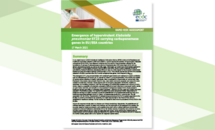Risk Assessment: Emergence of hypervirulent Klebsiella pneumoniae ST23 carrying carbapenemase genes in EU/EEA countries
This document assesses the risk associated with the dissemination of carbapenemase-producing hypervirulent Klebsiella pneumoniae (hvKp) of sequence type (ST) 23 and other STs in the European Union/European Economic Area (EU/EEA).
Executive summary
In an urgent inquiry in ECDC’s Epidemic Intelligence Information System (EPIS) Antimicrobial Resistance and Healthcare-Associated Infections (AMR-HAI) platform, Ireland reported the isolation of hypervirulent Klebsiella pneumoniae (hvKp) ST23, from diagnostic samples and from rectal or faecal samples collected for the surveillance of carriage of carbapenemase-producing Enterobacterales (CPE) since March 2019 with two distinct geographical clusters as well as sporadic cases. Information on further hvKp ST23 isolates detected in the European Union/European Economic Area (EU/EEA) were either found in public databases (n=26) or submitted by National Reference Laboratories (NRLs) in reply to a data request to the European Antimicrobial Resistance Genes Surveillance Network (EURGen-Net) (n=12). The analysis showed that several of the isolates detected in EU/EEA countries after 2012 carried carbapenemase genes, most frequently blaOXA-48.
This emergence of K. pneumoniae isolates with combined hypervirulence and resistance to reserve antibiotics such as carbapenems is of concern as, in contrast to ‘classic’ K. pneumoniae strains, hvKp strains are capable of causing severe infections in healthy individuals, often complicated by dissemination to various body sites. Previously, hvKp strains were primarily found in Asia, were mainly community-acquired, and were only rarely resistant to antibiotics. However, recent reports point to increasing geographic distribution, healthcare association and multidrug resistance. With the convergence of antimicrobial resistance and virulence in hvKp strains, there is a possibility of potentially untreatable (difficult-to-treat) infections in previously healthy adults. An even higher morbidity and mortality is to be expected if carbapenem-resistant hvKp strains spread in healthcare settings and affect a vulnerable patient population. Although only few cases and clusters have been reported in the EU/EEA to date, it is important to detect hvKp early and prevent further dissemination in healthcare settings in EU/EEA countries to avoid the establishment of carbapenemase-producing hvKp as a healthcare-associated pathogen similar to ‘classic’ carbapenemase-producing K. pneumoniae. The risk associated with the further dissemination of carbapenemase-producing hvKp for the patient population in the EU/EEA is currently considered to be moderate, but might become high in the future if hvKp ST23 is established in healthcare settings. Further studies are needed to determine the prevalence of hvKp ST23 in the EU/EEA.
Options for response include alerts to clinicians and clinical microbiology laboratories, the establishment of sufficient laboratory capacity to detect hvKp isolates, and the submission of all suspected hvKp isolates (for example, based on hypermucoviscosity and a positive string test) with or without additional antimicrobial resistance to National Reference Laboratories (NRLs) for further analysis. Prospective data collection on hvKp, including epidemiological data on cases and associated risk factors, would improve the understanding of national spread and transmission routes and determine the need for further surveillance and control measures.







